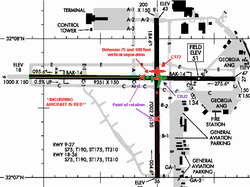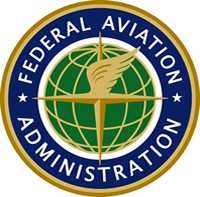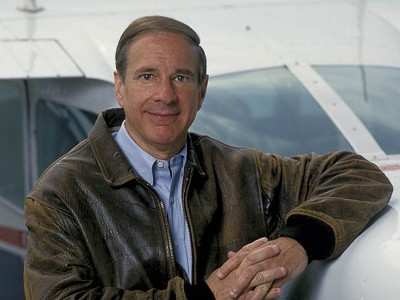Industry, FAA Debate Ways To Deal With Incursions
 Though most of
Wednesday's clamor in the halls of Congress had to do with
baseball, Roger Clemens, and steroids, another debate raged before
the House Subcommittee on Aviation -- what could be done to stem
what seems to be a growing tide of runway incursions at the
nation's airports.
Though most of
Wednesday's clamor in the halls of Congress had to do with
baseball, Roger Clemens, and steroids, another debate raged before
the House Subcommittee on Aviation -- what could be done to stem
what seems to be a growing tide of runway incursions at the
nation's airports.
Committee members heard from a variety of industry officials
regarding the problem. Below are excerpts from written testimony
given by Hank Krakowski, Chief Operating Officer of the Air Traffic
Organization of the FAA, before the subcommittee:
"At the Federal Aviation Administration, safety is our first
priority. I am pleased to report that 2007 was the safest year yet
for aviation in our Nation’s history. We work around the
clock to continually improve safety. We look at all areas to
improve safety, including airports and markings, operational
procedures, and equipment. In recent years, the FAA has formally
incorporated this culture of safety into our strategic plan, called
the Flight Plan, and we have devoted millions of dollars in
research and procuring technology to aid our controllers and pilots
in moving America safely. We place such a high priority on runway
safety that this is part of the performance plan for the Air
Traffic Organization, and we hold our employees accountable for
improvement. We have also reached out to the National Airspace
System stakeholders, from controllers to pilots to airport managers
to airlines to partner with us to improve runway safety.
"...An aggressive and effective FAA runway safety program has
reduced the number of serious runway incursions by 55 percent since
2001. In Fiscal Year 2007, we saw a 25 percent reduction in serious
runway incursions from 2006. There were 24 serious runway
incursions — that’s Category A and B incursions —
during 61 million aircraft operations, a significant reduction from
the 31 incursions in FY 2006, and the 53 incursions in FY 2001. But
while we have made improvements with the most serious of the runway
incursions, overall runway incursions increased in FY 2007 to 370,
up from 330 in FY 2006. Only 8 of the 24 serious incursions
involved a commercial airline flight, and none of these 370
incursions resulted in a collision. While most of these incursions
are Category C and D incidents, which pose little or no risk to the
public, the increase in incursions and the fact that serious
incursions are still occurring, prompted the Administrator to issue
a “Call to Action” on runway safety.
"... Our nation’s busiest airports have runway
surveillance technology installed that improves controller
situational awareness on the airport movement area. The FAA has
spent over $404 million to date to acquire and deploy the next
generation of ground surveillance technology, known as Airport
Surface Detection Equipment — Model X or ASDE-X for short.
Eleven towers in the system have ASDE-X installed, and we have
accelerated our installation schedule by one year — the
target completion date for the last system is now September 2010.
The FAA will commit more than $806 million over a 30-year period on
equipment, installation, operations and maintenance of the 35
ASDE-X systems.
 "... Twenty of the
busiest airports in America were identified for targeted Runway
Safety Action Team visits based on a combination of a history of
runway incursions, wrong runway events, and wrong runway risk
factors. The Runway Safety Action Team visits involved service
analysis meetings with air traffic control, both management and
controllers, safety inspectors from FAA and the airports, and
airport managers and operators. Just through the interaction and
discussion among these groups, action plans to mitigate identified
risks were finalized. These meetings identified over 100 short term
fixes that could be accomplished within 60 days, including new or
improved signage, improved marking, driver training, and other
actions. This proves that a “common sense” approach to
curbing runway incursions exists. Not all measures to improve
runway safety will involve fielding expensive equipment and new
systems. Quick and relatively inexpensive solutions include
improving airfield markings, adding targeted training for
controllers and aircrews, and fine-tuning air traffic procedures.
Incorporating the lessons learned through the meetings with the
initial 20 airports, FAA has identified a second tier of 22
airports we will be expanding this program to cover next.
"... Twenty of the
busiest airports in America were identified for targeted Runway
Safety Action Team visits based on a combination of a history of
runway incursions, wrong runway events, and wrong runway risk
factors. The Runway Safety Action Team visits involved service
analysis meetings with air traffic control, both management and
controllers, safety inspectors from FAA and the airports, and
airport managers and operators. Just through the interaction and
discussion among these groups, action plans to mitigate identified
risks were finalized. These meetings identified over 100 short term
fixes that could be accomplished within 60 days, including new or
improved signage, improved marking, driver training, and other
actions. This proves that a “common sense” approach to
curbing runway incursions exists. Not all measures to improve
runway safety will involve fielding expensive equipment and new
systems. Quick and relatively inexpensive solutions include
improving airfield markings, adding targeted training for
controllers and aircrews, and fine-tuning air traffic procedures.
Incorporating the lessons learned through the meetings with the
initial 20 airports, FAA has identified a second tier of 22
airports we will be expanding this program to cover next.
"...FAA has also continued to make progress in improving Runway
Safety Areas (RSAs). RSAs enhance safety in the event of an
undershoot, overrun, or excursion from the side of the runway. In
FY 2000, FAA started an ambitious program to accelerate RSA
improvements for commercial service runways that do not meet
standards. The FAA developed a long-term completion plan that will
ensure that all practicable improvements are completed by 2015.
"Finally, the FAA is seeking input from NATCA on revamping
policies for issuing taxi clearances. We are also working with
NATCA to implement a voluntary reporting system for air traffic
controllers similar to the Aviation Safety Action Program (ASAP)
with airlines, pilots, airport operators, and the FAA. In my role
at United, I was responsible for four ASAP programs for pilots,
dispatchers, mechanics, and flight attendants. Because of this
work, I am convinced that information from a voluntary reporting
system will help us to spot trends and prevent future runway
incursions.
"The FAA is committed to designing an end-to-end system that
seeks to eliminate runway incursions while accommodating human
error. The FAA plans on creating a standing Runway Council Working
Group to look at the data and address root causes, and continue to
involve all who play a part in runway safety. We all have a role in
the solution. Every reported runway incursion will be taken
seriously, investigated thoroughly, and analyzed to determine the
causal factors. The FAA continues to seek ways to improve
awareness, training, and technologies and we look forward to our
collaboration with airlines, airports, air traffic control and
pilot unions, and aerospace manufacturers to curb runway
incursions. We appreciate the Committee’s interest in safety,
and welcome your counsel and assistance in our efforts to reduce
runway incursions and improve safety in our nation’s aviation
system."
AOPA's Boyer Says FAA Needs Dedicated Runway Safety
Director
Phil Boyer, president of the Aircraft Owners and Pilots
Association, noted the FAA incorrectly attributes 72 percent of all
runway incursions from FY2003 through FY2006 to involving general
aviation aircraft -- when AOPA's numbers state only 44 percent of
all incursions in that time were pilot deviations involving GA
planes, and a whopping 92 percent of those cases were classified as
less severe, Category C and D incursions.
"Clearly, we have a problem. And, the “we” refers to
the airlines, general aviation, the FAA, the air traffic
controllers, the airports -- every member of the aviation
community. The number of reported incursions may be low when
compared to the total number of operations conducted each year, but
the potential for a catastrophic accident, makes runway safety an
area of special concern for the aviation community. The potential
for a runway incursion will exist as long as aircraft are operated.
Unfortunately, there is no quick fix or easy solution. But one
thing is apparent, what has been done and what is being done is not
good enough.

"The November 2007 Government Accountability Office (GAO)
Aviation Runway and Ramp Safety report states “FAA’s
Office of Runway Safety has not carried out its leadership
role.” While runway safety is a shared responsibility, the
AOPA Air Safety Foundation believes the FAA must once again make it
a national priority and a first step would be to have the Director
of the Office of Runway Safety reporting directly to the
Administrator.
"A cursory look at history shows that during times of inadequate
leadership from the FAA, the number of runway incursions increases.
In 1990, an all-time high of 281 runway incursions occurred and the
National Transportation Safety Board (NTSB) added the prevention of
runway incursions to its Most Wanted Safety list. Under FAA
leadership and coordination, progress was made and 1993 marked a
low with 186 incursions. However, we quickly saw FAA’s focus
and resources shift to other priorities and the result was a
dramatic increase in runway incursions through the mid-90s.
"Back as a top priority, in 1999, the FAA announced a new runway
safety initiative, created a new program office, reestablished
runway incursion action teams, held regional workshops, and created
new pilot programs. A great deal of time, energy and resources was
devoted to runway safety. Runway safety was an industry government
partnership, and the AOPA Air Safety Foundation worked very closely
with the FAA’s Office of Runway Safety on training, outreach,
and education. It was a cooperative and effective campaign.
Progress was being made but unfortunately FAA’s attention was
once again diverted and existing partnerships dissolved.
"As the GAO report noted, the FAA's Office of Runway Safety has
not updated the national runway safety plan since 2002 despite
policy that it be upgraded every two to three years. During this
time the office was without a permanent director for two years and
its staff was reduced by almost half. With the FAA forecasting an
increase in the number of operations over the next decade, the AOPA
Air Safety Foundation believes the FAA needs to once again make
runway safety a national priority. Long-term, sustainable
improvements in runway safety require constant, consistent and
continual FAA leadership."
ACI-NA Stresses Need For AIP Funding
 Greg Prinicipato,
President of Airports Council International–North
America’s (ACI-NA), emphasized that airports have taken an
aggressive stance to address the issue of runway incursions -- but
those facilities need all the help they can get, specifically
through the currently-stalled Airport Improvement Program.
Greg Prinicipato,
President of Airports Council International–North
America’s (ACI-NA), emphasized that airports have taken an
aggressive stance to address the issue of runway incursions -- but
those facilities need all the help they can get, specifically
through the currently-stalled Airport Improvement Program.
"Following ACI-NA’s participation in the Call to Action
meeting with the Federal Aviation Administration (FAA) last August,
72 of the 75 targeted large and medium airports have completed
upgrades for improved centerline painting and markings on their
taxiways and the four others are voluntarily accelerating the June
30, 2008, deadline set by FAA."
According to Principato's testimony, 28 small airports have
already voluntarily upgraded their markings, 173 airports plan to
upgrade by June 2008, and an additional 50 airports plan to
complete the work by the end of 2008. Another 29 airports have
committed to enhancing their markings in 2009, while 28 airports
have expressed interest but have not yet provided a target
completion date
"As you may know, many smaller airports work with private
contractors for painting and, given the fact that no Airport
Improvement Program (AIP) grants are being approved or distributed,
some airports are unable to contract for these services at this
time."
"As a new FAA reauthorization bill has not yet been passed by
Congress, contract authority for the AIP program expired on
September 30, 2007. Congress, in a series of continuing
resolutions, provided temporary AIP contract authority, but only
through December 31, 2007.
"Without contract authority, FAA has not issued any new AIP
grants, limiting the ability of small and large airports to
complete safety and capacity projects."
NATCA's Forrey Says FAA Needs To Listen To Controllers'
Suggestions
Patrick Forrey, president of the National Air Traffic
Controllers Association, started off his remarks to the committee
with a familiar argument -- that there are fewer controllers
watching planes to prevent incidents, due to a hostile work
environment created by the FAA:
"No one here today is more responsible for the safety of the
runways at America’s airports than controllers and pilots.
NATCA has been trying to direct attention to the decreasing safety
margins in our skies and on our runways for years. We are no longer
alone. In the past few months, a host of independent federal
watchdogs have joined the chorus in raising concerns about aviation
safety.

"...In November, the GAO issued a report that warned of “a
high risk of a catastrophic runway collision” occurring in
the United States. In December, the Transportation
Department’s Inspector General launched an investigation on
the role that workplace conditions played in several close calls at
FAA facilities in Illinois. And the NTSB recently added runways
incursions and incidents caused by air traffic controller fatigue
to their 2008 list of Most Wanted Aviation Safety Improvements.
"...Today there are 1,500 fewer fully-certified controllers than
there were on 9/11 -- leaving fewer eyes to watch more planes, and
the result is increased controller fatigue. If the FAA were to
return to the bargaining table where the parties left off and
negotiate in good faith with NATCA, the effort would make staying
in the FAA more attractive to both newly-hired controllers and
those eligible for retirement."
Forrey then offered additional suggestions, including greater
cooperation between controllers and the FAA in implementing new
ways to curb safety issues:
"...NATCA recommends that the FAA work in collaboration with the
Union in the development and deployment of new technology. Under
the liaison program, the FAA and NATCA worked side-by-side in the
creation of new technologies. ASDE-X, an effective surface
surveillance system, is a product of that collaboration. NATCA
recommends the deployment of this technology at all airports
throughout the country with mid- to high-traffic density.
"NATCA further recommends that the liaison program, dismantled
by the FAA in 2003, be reinstituted.
"...Because runway incursions often occurs when the layout of
taxiways force aircraft to cross a runway in route to a second
runway or gate, NATCA recommends that End-Around Taxiways be
constructed and utilized at all airports where such construction is
possible.
"...NATCA stands by ready, willing and able to offer real
solutions. We can only hope that the FAA is really listening."
 ANN's Daily Aero-Linx (05.06.25)
ANN's Daily Aero-Linx (05.06.25) ANN's Daily Aero-Term (05.06.25): Ultrahigh Frequency (UHF)
ANN's Daily Aero-Term (05.06.25): Ultrahigh Frequency (UHF) ANN FAQ: Q&A 101
ANN FAQ: Q&A 101 Classic Aero-TV: Virtual Reality Painting--PPG Leverages Technology for Training
Classic Aero-TV: Virtual Reality Painting--PPG Leverages Technology for Training Airborne 05.02.25: Joby Crewed Milestone, Diamond Club, Canadian Pilot Insurance
Airborne 05.02.25: Joby Crewed Milestone, Diamond Club, Canadian Pilot Insurance







